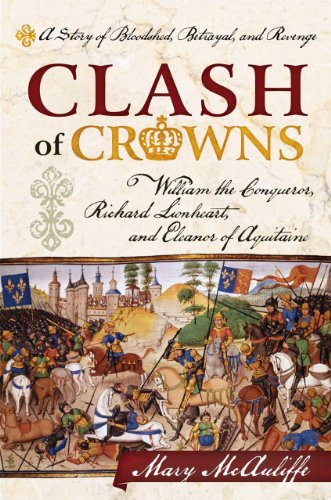
Clash of Crowns
William the Conqueror, Richard Lionheart, and Eleanor of Aquitaine—A Story of Bloodshed, Betrayal, and Revenge
- اطلاعات
- نقد و بررسی
- دیدگاه کاربران
نقد و بررسی

April 9, 2012
McAuliffe's well-researched and detailed newest (after Dawn of the Belle Epoque) recounts the familial and political tensions between England and France, which the author traces to Duke William of Normandy's conquering of the former in 1066. He and his descendants remained active in the Norman duchy, leading to conflicted loyalties, and attendant betrayals and battles. This interesting narrative focuses primarily on Richard Lionheart (son of Henry II and Eleanor of Aquitane, and great-great grandson of William the Conqueror) and his rivalry with King Philip II of France, who resolved to change the notion that his country's kings were "pitifully weak." Their enmity manifested itself in Richard brashly constructing the mighty fortress Château-Gaillard on the border of French and English holdings, and Philip declaring his intentions to seize it, "were its walls of iron." Though William and Eleanor are given relatively short shrift, Richard Lionheart's life is thoroughly toldâfrom his imprisonment by Duke Leopold of Austria (during which Richard continued to strategize), his failed betrothal to Philip II's youngest sister, and to his unexpected death by one of his own armory's arrows, repurposed and let fly by an enemy to whom Richard, on his deathbed, gave 100 shillings. Supplemented with a timeline, a dramatis personae, and extensive notes, fans of medieval European history will delight in McAuliffe's rich tale.

April 15, 2012
A recovery from romantic fable of some of the brightest stars of Western medieval history. Among the many notables, McAuliffe (Dawn of the Belle Epoque: The Paris of Monet, Zola, Bernhardt, Eiffel, Debussy, Clemenceau, and Their Friends, 2011, etc.) reintroduces us to the likes of William the Conqueror, Barbarossa, Rollo the Viking, Robert Curthose of Normandy, Louis the Fat and a cadre of Henrys. (Readers will have no problem keeping them straight--the author appends a table of key people and a helpful chronology). After assessing the famously dysfunctional English household of Henry II and Eleanor of Aquitaine, McAuliffe focuses on the truly excellent adventures of their son, Richard Lionheart. In clear prose, the author examines Richard's internecine struggles, usually with his brother, his feckless Third Crusade fighting Saladin and his many clashes with archenemy Philip of France. In these eclectic pages, we learn of 12th-century statecraft, the design of fortress castles and how to lay siege to them, the wages of mounted knights and foot soldiers, the rise of the notion of romance and the wonderful victuals consumed at great state dinners. The author weaves a selective tapestry that does not scant personal qualities of her featured players. She reveals the Conqueror's baldness and staunch Eleanor's attractions. Also, it appears that Lionheart may have been gay, according to the author's research. With measured verve, McAuliffe presents an accessible text that occasionally approaches Barbara Tuchman's talented touch.
COPYRIGHT(2012) Kirkus Reviews, ALL RIGHTS RESERVED.

May 15, 2012
Independent historian McAuliffe's (Paris Discovered: Explorations in the City of Light) title is a bit misleading: she touches only briefly on the reign of William the Conqueror and the importance of Eleanor of Aquitaine. Her actual subject is the conflict between England's flamboyant warrior king Richard I and the more pragmatic Philip II of France and how their struggle shaped English-French relations over the following centuries. Being both a king and a duke put Richard in a peculiar situation, as he was simultaneously England's absolute ruler and, as Duke of Normandy, vassal to another king. The author provides a thorough discussion of that topic and also covers medieval warfare, presenting evidence that wars were fought not as huge pitched battles but rather conducted unglamorously, through lengthy sieges. McAuliffe credibly describes the unromantic work of sappers--miners who tunneled under walls and castles to destroy them. It was often their work that turned the course of battles and, indeed, wars. VERDICT While this work strangely glosses over two of the rulers in its title, it is a valuable effort that examines a pivotal time in the relationship between England and France. Best for lay readers.--Brian Renvall, Mesalands Community Coll., Tucumcari, NM
Copyright 2012 Library Journal, LLC Used with permission.




دیدگاه کاربران